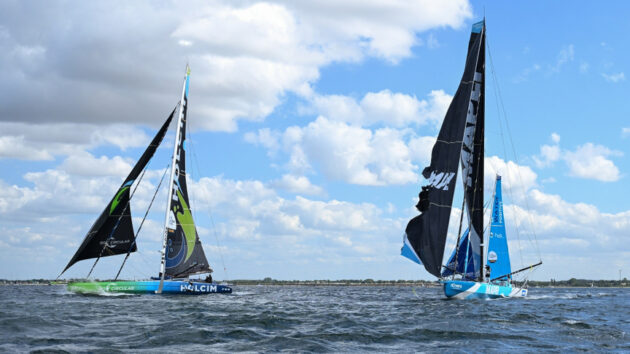U.S. LNG Developers
Scramble for Investment
Before Global Gas
Surplus Hits
September 9, 2025
Reading time: 5 minutes
Full Story: The Energy Mix
Mitchell Beer

September 9, 2025
Reading time: 5 minutes
Full Story: The Energy Mix
A looming global surplus of liquefied natural gas (LNG) has U.S. producers scrambling to tie down financing for their projects, even as industry voices and a senior European politician predict continuing demand growth while the Canadian government touts potential LNG exports to Germany.
U.S. developers, no doubt eager to cash in on Donald Trump’s urging to “Drill, Baby, Drill”, are “racing to cash in on the nation’s natural gas export boom while they still can, as global LNG supply will exceed demand by 2027,” Bloomberg reports. The mounting market jitters affect four projects with 63 million tons of capacity per year that are “still awaiting final investment decisions,” the news agency writes, while creating “headwinds” for $35 billion worth of projects that are already under construction.
The news story cites a BloombergNEF projection that global LNG supply will surge past demand by 2027. And that isn’t the only challenge facing companies or countries looking to add new projects to the global mix.
“By 2030, U.S. rival Qatar will have finished its own years-long LNG buildout, further damping appetite for new terminals,” Bloomberg writes. “And by 2031, a massive pipeline expansion by Gazprom PJSC could begin funneling more of Russia’s natural gas to China, possibly displacing as much as 40 million tonnes of LNG demand per year.”
The BloombergNEF analysis reinforces concerns uncovered by The Energy Mix and Berlin-based Clean Energy Wire in late August, after Prime Minister Mark Carney and Energy and Natural Resources Minister Tim Hodgson travelled to Germany to pledge a first wave of Canadian LNG deliveries in “as little as five years”. A week later, London, UK-based Crown LNG announced a $15-billion LNG development off the coast of Newfoundland that has quickly raised alarm bells in the proposed host community of Fermeuse.
“I think you’re probably talking about five to seven years,” Hodgson told Politico EU in an interview in Berlin. And in a CTV News interview September 7, European Parliament President Roberta Metsola reinforced the idea that the EU might even pay a premium for Canadian oil as well as gas to help it free itself from Russian supplies.
“We found ourselves when Russia invaded Ukraine, that we were completely, to a certain extent, reliant on a very unreliable partner for gas and oil, and that meant that we have had to divest, uncouple ourselves, and we’re almost completely done,” she told host Vassy Kapelos. “And where do we go? Where do we look? We have to look across the Atlantic, and the discussions are absolutely in that direction.”
But multiple analysts contacted by The Mix and CLEW said they saw limited prospects for LNG trade.
“In the medium and long term, we’re not anticipating an increase in gas demand, certainly not in Western Europe,” Pawel Czyzak, Europe programme director at the Ember energy think tank, said in an email. EU gas demand fell 17% between 2021 and 2024, spurred largely by the energy shock following Vladimir Putin’s invasion of Ukraine, and consumption will continue to shrink through 2030 as Europe electrifies its economy.
That means the continent “is already heavily oversupplied towards 2030,” he said, and “that oversupply will get even more severe if the questionable fossil fuel imports from the EU-U.S. trade [and tariff deal] are implemented.”
Ana Maria Jaller-Makarewicz, lead energy analyst, Europe with the Institute for Energy Economics and Financial Analysis (IEEFA), said the EU is on track to reduce its gas imports 25% by 2030 under REPowerEU, its plan to end its dependency on Russian fossil fuels by 2027 through increased energy efficiency, faster growth in renewable energy, and diversified energy supplies. The plan included voluntary gas reduction targets for 2022, 2023, and 2024, and the bloc exceeded its targets for the first two years, though Jaller-Makarewicz warned in a May, 2024 commentary that EU targets for 2024 and 2025 could allow for increased gas use.
Even so, “EU efforts to curb gas demand and diversify energy sources have been vital for Europe’s security of supply,” she told The Mix in an email. “Cutting dependency on gas from Russia or any other country can be achieved if gas consumption reduction measures continue in place.”
With an affordable energy action plan set to replace up to 100 billion cubic metres (more than 3,500 billion cubic feet) of gas by 2030, she added, “the bloc could satisfy demand without additional gas infrastructure or increased imports.”
On LinkedIn, Adrian Hiel, Brussels-based director of the Electrification Alliance, wrote that he has “a lot of time and respect” for Carney, but can’t understand the push to sell Canadian LNG in Europe.
“There is absolutely no window in the next 25 years when you can think, oh, the EU will really need that LNG then,” he said. “It’s nothing but one effort after another to push expensive, inefficient gas out of the EU’s energy system.”
Heil laid out this point-by-point chronology for the continent’s fossil fuel reduction strategy:
• 2023: EU gas demand is down 19% from 2021-2023;
• 2025/2026: Gas demand largely flat; launch of Clean Industrial Deal, Affordable Energy Action Plan, and Electrification Action Plan, all aiming to reduce gas consumption while increasing electrification and renewables;
• 2026-2030: Enormous glut of U.S. LNG comes to market;
• 2030: EU gas consumption down another 7%;
• 2032 (at the earliest): Canadian LNG export facilities are ready (at the earliest);
• Mid-2030s: No more free credits under Europe’s Emissions Trading System (EU ETS), so industrial electrification grows even faster;
• 2035: EU electricity supply is mostly renewable, so no LNG is needed;
• 2040: Indicative target for National Building Renovation Plans to have phased out fossil fuel heating (though there are questions surrounding that target);
• 2050: Legally binding target to be net zero.
“Previous Canadian diplomats in the EU have been very clear behind closed doors that LNG sales from eastern Canada will never happen,” Hiel added in response to an online comment. Now, “certainly it costs the Germans nothing to say they want the LNG, and every country likes to have options, but the whole thing just doesn’t add up.”
Wikipedia









